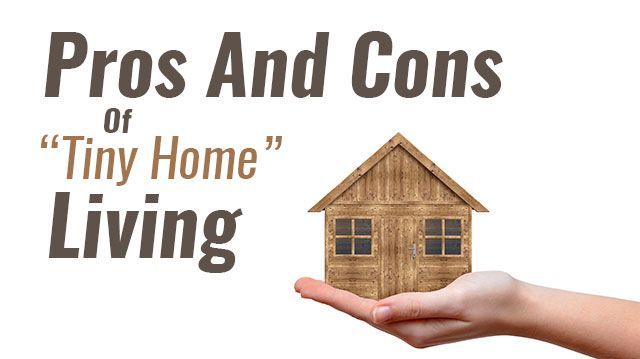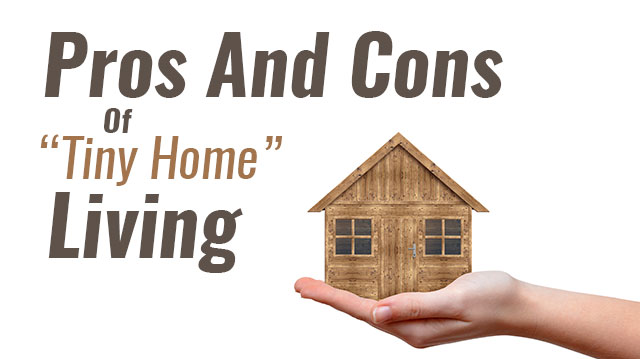
Out on the open road, your tiny house trailing behind you. It’s the modern American dream. Who wouldn’t want to be free from a landlord while reducing your carbon footprint? But it isn’t always an idyllic experience. Here are the pros and cons that you should be aware of before taking the “tiny house” plunge.
Pros of tiny-house living
They’re more affordable
Unlike traditional homes, tiny homes are an extremely affordable living option. Most will cost you around $15,000. After you pay for it, owning a tiny home means no mortgage and no monthly rent. To put it in perspective, if you rent an apartment for $1,250 a month, you spend $15,000 in one year on rent.
Smaller carbon footprint
People who live tiny live greener. Tiny homes produce less waste while encouraging you to be more mindful about what you bring into the home. Tiny homes can easily be powered with solar energy, and they’re very easy to heat and cool, thanks to their small size. Some owners can heat their tiny home for as little as $10 a month.
You accumulate less stuff
Tiny homeowners have very limited space, so they’re far less likely to accumulate junk. Purchase a tiny home and you might find yourself switching to ebooks and getting your news online, rather than have stacks of books and papers sitting around. You might also become more aware of the food you purchase. With little space for food storage, it’s important to be mindful at the grocery store.
Easy to clean
Tiny homes are far easier to maintain than larger homes. Because they’re small, cleaning a tiny home is much simpler and uses less cleaning products — saving money in the long run.
Cons of tiny-house living
It’s really tiny
So it goes without saying that a tiny home is, well, tiny, but just how tiny seems to elude millennials with hopes of living free from their landlord. Most tiny homes are anywhere between 120 and 700 square feet. Your new home could be the size of your current bedroom. It’s definitely something to think about.
Limited personal space
Want to stretch out and do yoga? You’ll need to step outside. Likewise, if you appreciate spending time alone, living in a tiny home with someone else might turn your dream into an introvert’s nightmare.
No landlord
 While it sounds like delicious freedom, living without a landlord — especially if you’re moving from a rental — means that all repairs and maintenance are your responsibility. It’s really nice to be able to call the management company at your complex if your faucet begins to drip. If the same thing happens in your tiny house, it’s up to you to call a plumber or fix it yourself.
While it sounds like delicious freedom, living without a landlord — especially if you’re moving from a rental — means that all repairs and maintenance are your responsibility. It’s really nice to be able to call the management company at your complex if your faucet begins to drip. If the same thing happens in your tiny house, it’s up to you to call a plumber or fix it yourself.
Home location
Some communities welcome tiny homes, but you might find local law enforcement to be unfriendly when it comes to parking your home for the night. Many green areas and parks are off-limits to tiny homes, and some cities have enacted ordinances against tiny homes.
Tiny homeowners report a higher quality of life than people who don’t live in a tiny home. Saving money, getting outside more and living with minimal space is exactly what some people want. If that’s you, a tiny house may be the way to go.
Do you know someone who lives in a tiny house? We’d love to hear about their experience.
—Megan Winkler
Megan Winkler is an author, historian, Neurosculpting® meditation coach, certified nutritional consultant and DIY diva. When she’s not writing or teaching a class, Megan can be found in the water, on a yoga mat, learning a new instrument or singing karaoke. Her passion for a healthy mind-body-spirit relationship motivates her to explore all the natural world has to offer.
Sources:
http://www.livingasimplelife.com/the-pros-and-cons-of-tiny-homes/#
http://tinyhousetalk.com/6-months-tiny-house-living-pros-cons
http://minimotives.com/2013/09/06/things-i-dont-like-about-my-tiny-house
http://abcnews.go.com/Business/living-tiny-home-benefits-drawbacks/story?id=17742823
http://americantinyhouseassociation.org/category/type/zoning

